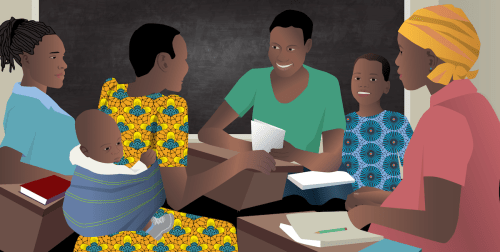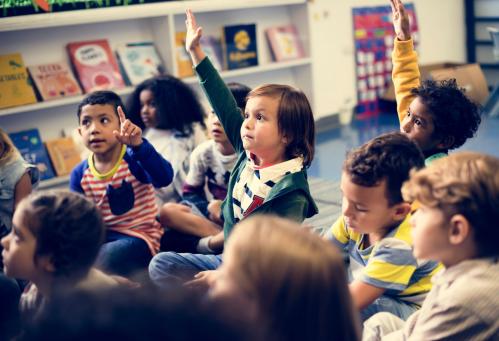Editor’s note: In the “Becoming Brilliant” blog series, experts explore the six competencies that reflect how children learn and grow as laid out by Kathy Hirsh-Pasek and Roberta Golinkoff in their new book “Becoming Brilliant.”
You don’t have to teach a young child to play. You don’t have to teach them to be creative. Children are naturally, deeply creative.
In fact, any time a child does or learns something new they have to be creative in their own, small way. They have to come up with something original, which they’ve never done before, and something useful, which can be used to solve the problem they may be working on. Although this type of creativity may not be what we think of as being behind the great works of Picasso or Bach, the important connection between play and the arts cannot be overstated.
While it’s easy for a young child to be creative before formal schooling, when their only job is to play and explore, it’s hard for children to retain that same sense of creative freedom once they’ve entered the classroom. Because of the current emphases on curriculum standards, the rigidness of students’ lessons deprives them of the best way of learning: through personal exploration and discovery.
Early schooling has become more academically focused, with kindergarten especially noted for moving away from child-directed activities and, disturbingly, towards high pressure teacher-led pedagogy. Engagement in the arts—which emphasizes personal ways of knowing, thinking about the self, and discovery—may be key to providing children with creative experiences. Fiction generally can be thought of as a safe space for trial and error: In fiction, children can make mistakes without consequences and try out different cognitive and emotional strategies. The arts, particularly theater, create that safe space to be filled with whatever topic the child chooses.
Different kinds of creativity
In psychological and educational research on creativity, we often talk about different types of “Cs”: “Pro-C,” “Big C,” “Little-c,” and “mini-c.” “Pro-C” and “Big-C” are what we’re usually talking about when we use the word “creativity”—advances in the arts, engineering, or sciences with innovation and usefulness at the forefront.
Yet, it is “Little-c” and “mini-c” that are so critical to children’s growth, knowledge, and achievement. These can be thought of as the kinds of creativity children engage in when they’re discovering something new to them. Even when we as adults may consider the outcome obvious or well known, for children finding out something new—and, importantly, not just the outcome of the discovery but also the process involved—is foundational in later achievement and abilities.
Creativity and the arts
But how might we foster this type of exploration and creativity in our children?
One possibility is through engagement in pretend play and the arts. The type of pretend play that children engage in naturally has been theorized and researched as a foundation for creative thought and behavior. When children play, they are creating a protected space for themselves to make mistakes, build knowledge, and try out different emotions and social situations. Creation of knowledge on your own is the best way to learn—children and adults alike will remember more, and know more deeply, material that they have taught to themselves over material explained to them. And this is not just true for typical developing children: For example, children with Autism Spectrum Disorder also learn more social connectedness and social understanding when they actually embody and experience it for themselves, as opposed to being taught in a more traditional and straightforward manner.
This is not to say, of course, that the sciences, math, and engineering do not require or engender creativity—they absolutely do. But at the elementary and middle school levels, much of the coursework in these topics is based on recreating knowledge that is already well established in those fields—learning foundations so that in the future creativity can occur.
The arts require creativity in the moment, constant trial and error, discovery, and mistakes. In a detailed ethnographic analysis of high quality visual arts classes for adolescents, psychologists Lois Hetland, Ellen Winner, Kim Sheridan, and Shirley Veenema found that the key concepts being taught in arts classes—beyond learning how to hold a paintbrush or mold clay—were to stretch and explore thinking about materials and topics and to observe and reflect on how to engage in artistic work.
A similar analysis of acting classes found that theatre in elementary and high school fostered children’s self-trust, understanding of others’ thoughts, and emotions, emotional regulation, and paying close attention to other people. In both of these cases, systematic qualitative study of the art form showed how it engages metacognitive and creative skills for the student—thinking about thinking, reflecting on work, and building on previous knowledge. These “learning to learn” or “generalizable” skills are critical for children to gain and apply to their education more broadly.
It may be (and research is currently investigating this) that by learning these skills in an artistic way children will be better prepared for more traditional academic learning and creating their own knowledge. When children encounter failures and problems in their learning, knowing how to think about multiple solutions, how to overcome a simple solution, and build metacognitive strategies can be critical. The arts may provide learning opportunities and safety for the type of play and exploration, personal stretching, and self-trust, leading children to gain the confidence to be creative across domains.



Commentary
Creating their own worlds: Arts and learning
June 3, 2016